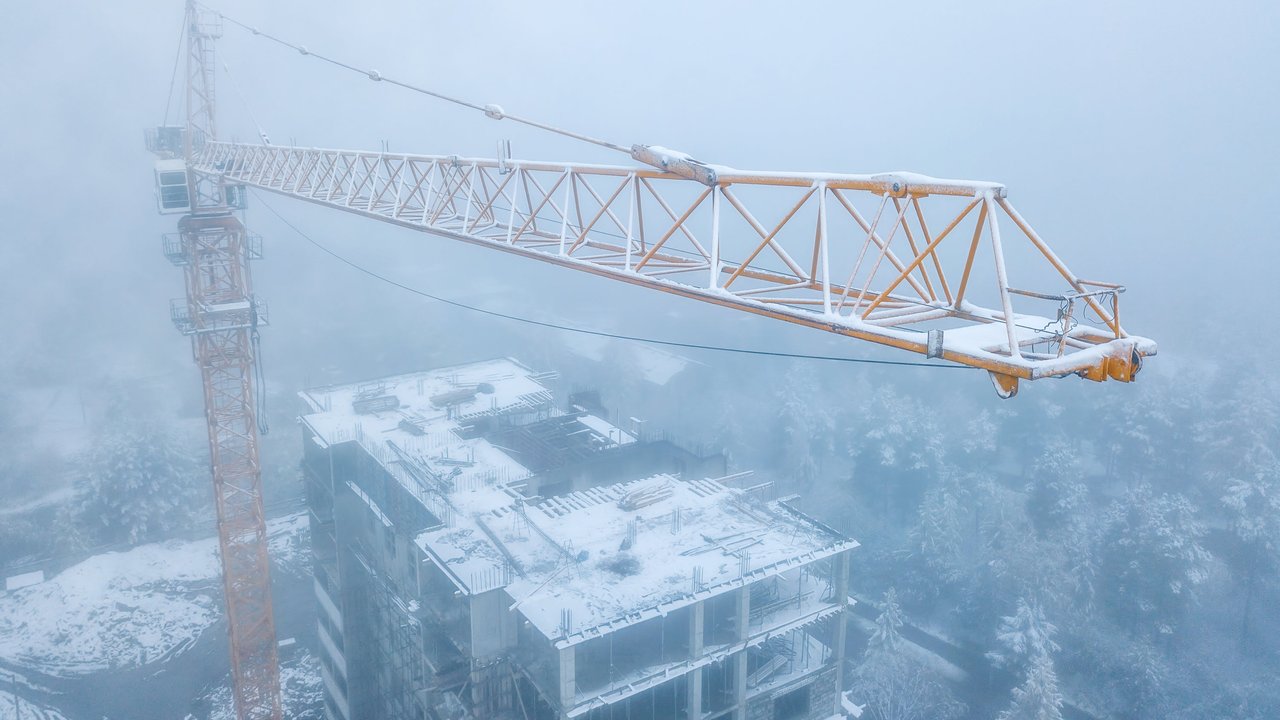
Tower crane collapse events
Risk management
properties.trackTitle
properties.trackSubtitle
The risk of tower crane collapse events can increase due to associated adverse weather, particularly during the winter months
Although there are many different types and configurations of tower cranes, the most common types we see consist of a tower section located on a fixed base with a jib attached to the tower via a slew mechanism. This mechanism allows the crane operator, through a gearing arrangement, to slew the jib around the construction site and then hold the jib in position via a slew brake. In normal operation, the slew brake is always engaged and the operator, through his control inputs, disengages the brake and moves the jib to the required position. The brake is then re-engaged until the next control input.
When the crane is left unattended, it is usually a requirement to leave the slew brake disengaged. This allows the jib to move freely and weathervane with the wind. Allowing the jib to move freely greatly reduces the stress imposed on the tower section and jib section. However, if this brake is engaged in a period of high wind, the stress imposed upon the structure can lead to failure. This is a particular risk during winter months.
Risk management: Health & Safety Executive guidance
The Health and Safety Executive (HSE) have investigated crane collapse events and subsequently provided guidance (available at www.hse.gov.uk/safety bulletins/luffing-jib-towercranes.htm). This document advises the following for all tower crane users:
- Ensure the most accurate up-to-date information is being used for the specific crane they are operating. This may include discussions or correspondence with the supplier or manufacturer as some manufacturers may have changed their guidance.
- Check that the information includes the correct minimum out-of-service radius for the specific crane being operated.
- Check, both after erection and periodically in-service, the function that releases the slew brake and places the crane in free slew.
- Check, both after erection and periodically in service, that the condition of the slew drive motors, gearboxes and slew ring bearing have not deteriorated to the extent that the crane is prevented from slewing freely.
- Check, both after erection and periodically in service, the setting and function of any devices that warn the operator that the crane jib has not been left parked at the correct out of service radius and/or the slew brake has not been released.
- Ensure that operators have been provided with instructions on how the crane should be placed in free slew and the correct radius at which the jib should be positioned when leaving the crane unattended. This should include measures to routinely check that the operators understand and are following the instructions provided.
- Undertake periodic checks that the buildings under construction, other cranes or high reach plant are not preventing the crane from free slewing. Consideration needs to be given to both front jibs and rear counter jibs.
Key risk measures
Crane owners/users should have a robust planned preventive maintenance (PPM) system along with prescribed safety checks. Detailed requirements and checklists are included in BS7121-2-5, the Lifting Operation and Lifting Equipment Regulations (LOLER) and the Provision and Use of Work Equipment (PUWER) Regulations, as well as detailed guides produced by the Construction Plant-Hire Association (CPA) including TCIG-0801.
Pre-use checks, regular in-service inspections and maintenance checks are essential and need to be recorded. Key aspects to check during maintenance include (but are not limited to):
- general condition of structures (e.g. fatigue cracks), fastenings, ties and machinery
- operation of alarms, warning lights, indicators, motion limiters and cab accessories
- presence of documentation and warning signs
- slewing mechanism, control gear, safety devices, cables and pulley block
In addition to a PPM system, cranes also require periodic thorough examinations as prescribed by LOLER. The thorough examinations would need to be carried out at:
- specified intervals
- after installation
- after major alterations or repair
- after exceptional circumstances affecting the safety of the crane (e.g. adverse weather conditions)
Examinations need to be undertaken by a Competent Person.
Construction insurance solutions and inspection services
We have a comprehensive range of construction insurance products covering all aspects of projects across the UK and Ireland.
Our engineering inspection services also help customers to maintain workplace equipment safety, optimise the efficiency of a vast range of plant and equipment, and comply with applicable health and safety legislation. Our team of technically-experienced Engineer Surveyors can perform the role of 'Competent Person' on tower crane inspections.

